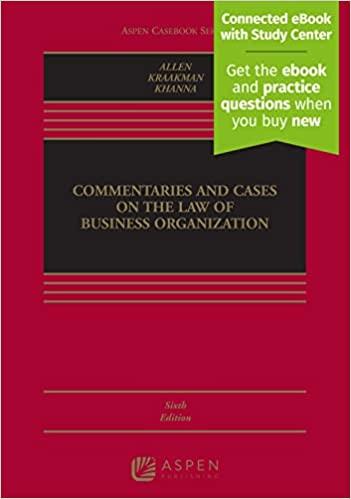Question
QUESTION 1 Disclaimers of warranty may be unconscionable in each of these situations, except if : ___. Two of these situation are unconscionable;select the situation
QUESTION 1
Disclaimers of warranty may be unconscionable in each of these situations,except if: ___.
Two of these situation are unconscionable;select the situation that a court likely will support.
- The court believes the disclaimer was forced on the buyer, with no opportunity to bargain over its form.
- There is a great disparity of bargaining power between the buyer and the seller.
- The disclaimer is conspicuous.
QUESTION 4
___ describes an action where liability of a seller is based on the theory that the manufacturer failed to use reasonable care to avoidforeseeable injuryto the ultimate user or consumer.
- TheMagnuson-Moss Act
- Strict liability
- Negligence
QUESTION 5
In an action for liability based onnegligence: ___ .
- theobvious danger rulecan be used for complete defense.
- Disclaimers are effective to shield manufacturers against liability.
- The manufacturer's duty of care extends to all persons who foreseeably might be injured if the manufacturer doesnotexercise its duty of care.
QUESTION 6
If a consumer brings suit against the manufacturer, the retailer is relieved of its responsibility for thefitness and merchantabilityof the goods.
- True
- False
QUESTION 7
Under the warranty regulations of the FTC, when a warranty is giventhe seller must disclose the required information in one single document.
- True
- False
QUESTION 8
Goods soldwith faultsare sold withoutthe implied warranties ofmerchantabilityandfitness for a particular purpose.
- True
- False
QUESTION 9
- Under the Magnuson-Moss Warrant Act and FTC regulations, the seller isnotrequired to give a written warranty.
- True
- False
QUESTION 12
In determining whether a product isinherently dangerousor has beendefectively designed, courts look at: ___ .
- whether the seller can pass on the costs of injuries as higher prices in the marketorif they should be borne by the injured person
- whether anything else could have been done to make the product safergiven the practical and technological limitations of the time
- what other companies in the industry are doing
QUESTION 13
Afull warrantyincludes each of these,except: ___ .
Select the one that is not included in a full warranty.
- It excludes and limits payments for consequential damages.
- The warranty isnotlimited in time.
- The warrantor will fix or replace any defective product free of charge.
QUESTION 14
To constitute afull warranty, the warranty must cover the whole product.
- True
- False
QUESTION 15
In order to exclude theimplied warranty of merchantability, the seller must put the exclusion in writing.
- True
- False
QUESTION 17
If a seller wishes to be relieved of the responsibility forimplied warranties, the sales contract clearly must provide that the parties didnotintend the implied warranties to become part of the contract.
- True
- False
QUESTION 18
Theimplied warranty of titlediffers from other warranties in that it protects buyers in their ownership of the goods bought.
- True
- False
QUESTION 19
Under the UCC, theimplied warranty of merchantabilityapplies to the sale of food and drink.
- True
- False
QUESTION 21
Under the UCC, some of the benefits of warranties extend to persons who didnotthemselves purchase the particular defective goods.
- True
- False
Step by Step Solution
There are 3 Steps involved in it
Step: 1

Get Instant Access to Expert-Tailored Solutions
See step-by-step solutions with expert insights and AI powered tools for academic success
Step: 2

Step: 3

Ace Your Homework with AI
Get the answers you need in no time with our AI-driven, step-by-step assistance
Get Started


